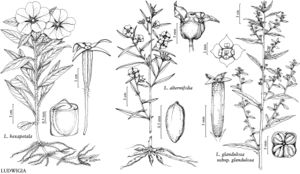Difference between revisions of "Ludwigia hexapetala"
Syst. Bot. 16: 243. 1991.
imported>Volume Importer |
imported>Volume Importer |
||
| Line 70: | Line 70: | ||
|publication year=1991 | |publication year=1991 | ||
|special status= | |special status= | ||
| − | |source xml=https://xjsachs2@bitbucket.org/aafc-mbb/fna-data-curation.git/src/ | + | |source xml=https://xjsachs2@bitbucket.org/aafc-mbb/fna-data-curation.git/src/e39f0e846f172941159b2045254d62d10d9823f6/coarse_grained_fna_xml/V10/V10_230.xml |
|subfamily=Onagraceae subfam. Ludwigioideae | |subfamily=Onagraceae subfam. Ludwigioideae | ||
|genus=Ludwigia | |genus=Ludwigia | ||
Latest revision as of 10:31, 9 May 2022
Herbs, subshrubs, or emergent aquatics, adventitious roots sometimes forming a thick mass 10–23 cm at submerged nodes, sometimes woody at base, white pneumatophores 5–10 cm often on submerged stems. Stems floating or creeping and ascending to erect, terete, 20–200(–400) cm, simple to densely branched apically, glabrous (floating) or sparsely to densely villous (emergent), sometimes villous only on inflorescence. Leaves: stipules ovate or deltate, 0.7–2 × 0.5–1.1 mm, not succulent, apex subacute, mucronate; petiole flattened, 0.5–2(–2.5) cm; blade narrowly oblanceolate, narrowly elliptic, or lanceolate to obovate or spatulate, (1.5–)4.2–10.7(–13.5) × (0.5–)0.8–3 cm, chartaceous, base cuneate or attenuate, margins entire, apex acute to obtuse, rounded or truncate, sometimes mucronate, surfaces not shiny, usually glabrous, sometimes villous on petiole and veins or throughout; bracts not reduced. Inflorescences: emergent stems sometimes in leafy racemes, sometimes reflexed, flowers solitary in leaf axils; bracteoles obovate to narrowly obovate, 1–1.8 × 0.7–0.8 mm, apex acute or acuminate, attached on distal 1/2 of pedicel or at ovary base. Flowers: sepals ovate-deltate or lanceolate-deltate, (8–)12–19 × 2–5 mm, chartaceous, margins entire, apex acuminate, surfaces ± densely villous; petals bright yellow, sometimes with orange base, fan-shaped, (15–)20–30 × (12–)16–25 mm, apex emarginate or mucronate; stamens 10(or 12), in 2 unequal series, yellow, filaments recurved, shorter ones (1.6–)2.3–5.2 mm, longer ones (3.1–)3.6–7.5 mm, anthers oblong, (1.2–)1.7–4 × 1–1.5 mm; ovary subcylindric, terete, 10–18 × 2–3 mm, apex ± broadened, glabrous or sparsely to densely villous; nectary disc slightly raised on ovary apex, yellowish green, 2–4 mm diam., lobed, glabrous or ringed with white hairs; style yellow, 6–10 mm, glabrous, stigma subcapitate-globose, 0.5–1.5 × 1.5–2.5 mm, often exserted beyond anthers. Capsules cylindric or subclavate, terete, sometimes curved, (12–)16–24(–30)× 2.5–4 mm, with thick woody walls, irregularly and tardily dehiscent, pedicel (9–)13–25(–85) mm. Seeds embedded in wedge-shaped piece of endocarp, 0.8–1 × 0.8–1 mm. 2n = 80.
Phenology: Flowering spring–late fall.
Habitat: Wet places, along slow-moving rivers, streams, canals, ditches, often growing into main channel as aquatic weed.
Elevation: 0–200[–2600] m.
Distribution
Ala., Ark., Calif., Fla., Ga., Ky., La., Miss., N.Y., N.C., Oreg., Pa., S.C., Tenn., Wash., Central America (Costa Rica), South America (Argentina, Bolivia, Brazil, Chile, Colombia, Ecuador, Paraguay, Peru, Uruguay), introduced in w Europe (Belgium, France, Spain).
Discussion
Ludwigia hexapetala (2n = 80) was formerly included with L. grandiflora (2n = 48) in L. uruguayensis (Cambessèdes) H. Hara, and some authors (G. L. Nesom and J. T. Kartesz 2000) still consider them to be a single species. The small but consistent morphological differences and different ploidy levels argue for keeping them distinct at the species level.
Fernald described Jussiaea michauxiana (1944), since he thought that J. grandiflora Michaux (1803) was a homonym (not J. grandiflora Ruíz & Pavon). However, it was later determined that the volume containing the Ruíz & Pavon name was published in 1830 (not 1802) making the name by Michaux valid and legitimate, and the name by Fernald an illegitimate substitution. Plants now known as Ludwigia hexapetala were included in the circumscription of L. uruguayensis (Cambessèdes) H. Hara (based on J. uruguayensis Cambessèdes) by P. H. Raven (1963[1964]) and P. A. Munz (1965).
Selected References
None.
